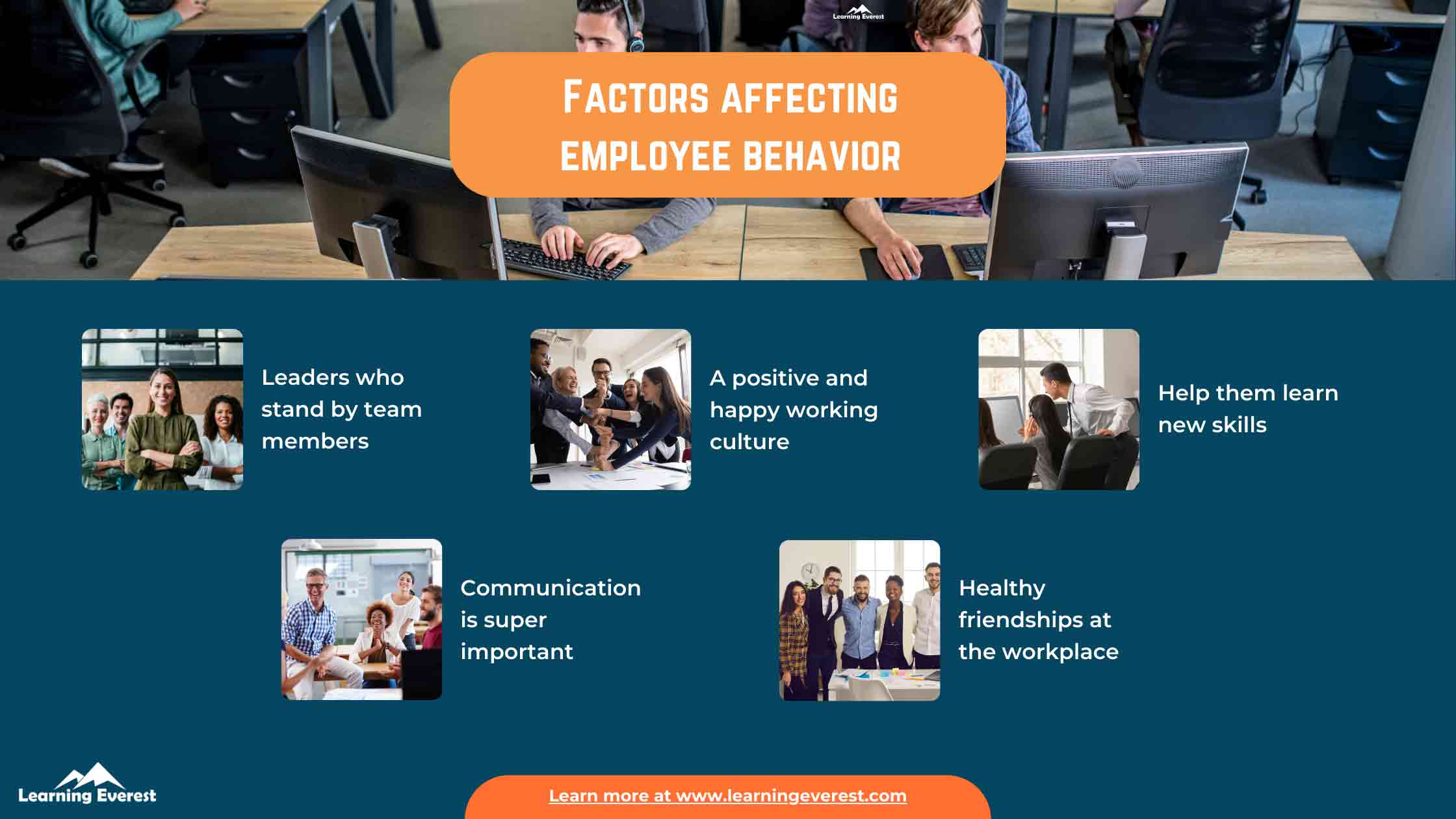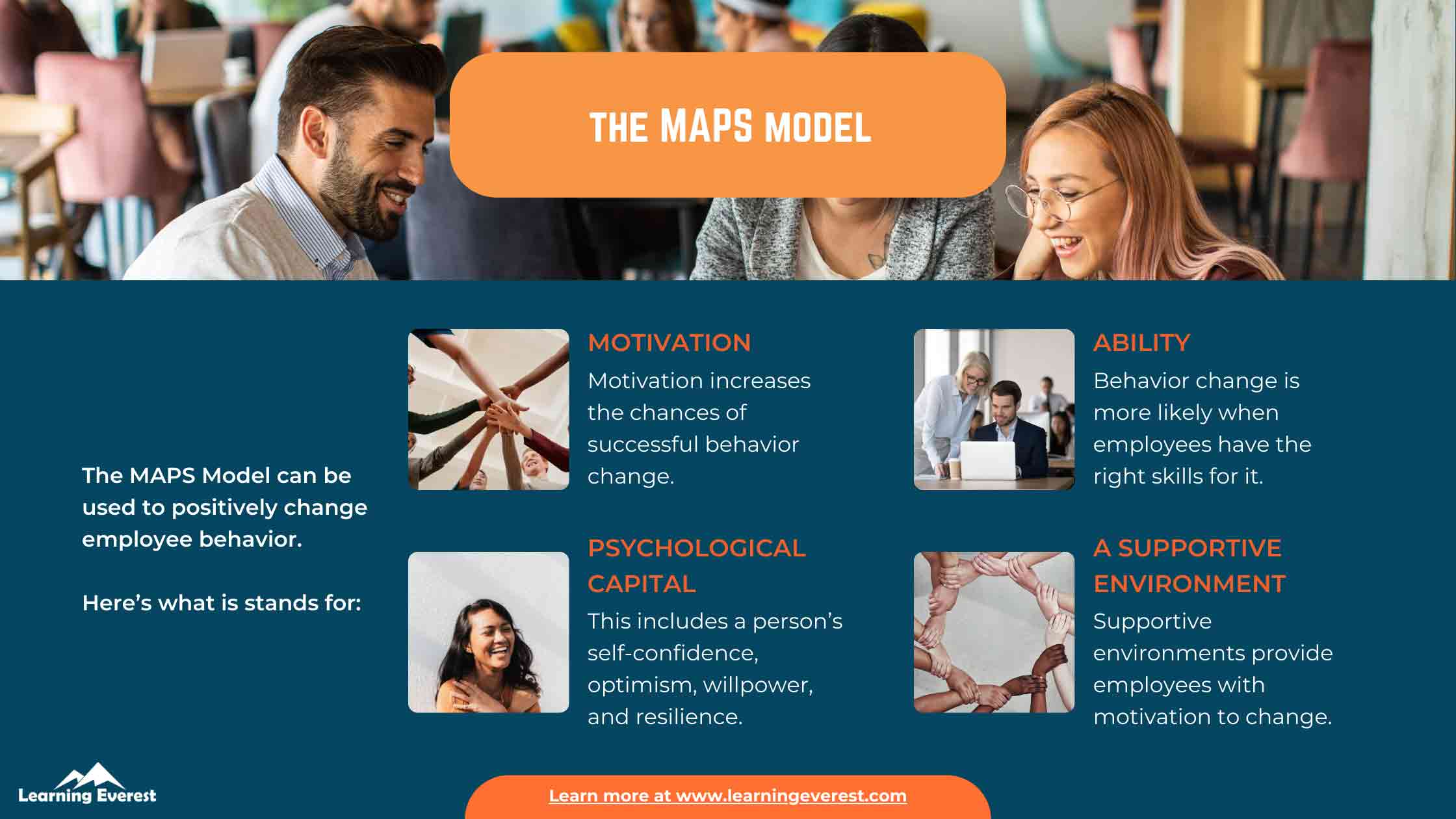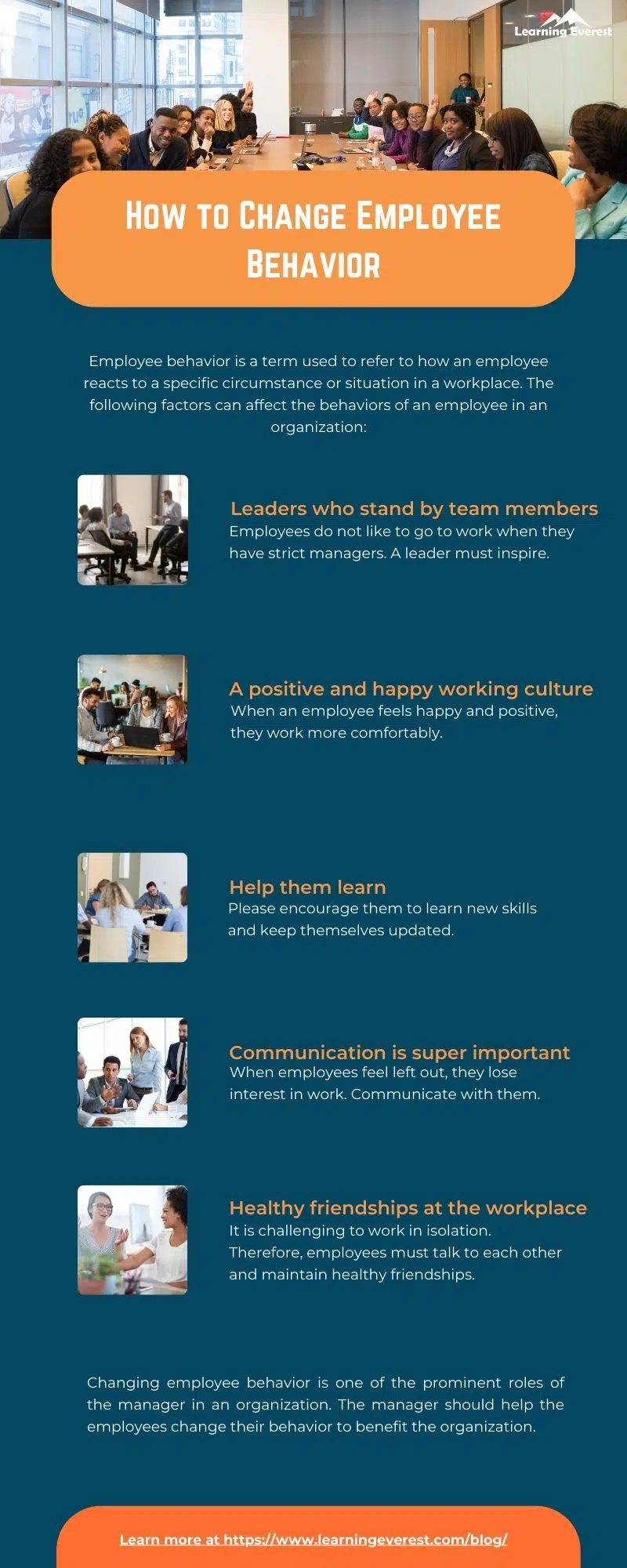To change employee behavior is essential to any organization. The change in employee behavior is for both mutual benefit and success. Employee behavior is a term used to refer to how an employee reacts to a specific circumstance or situation in a workplace. An employee's behavior must be sensible to maintain a healthy work culture.
Table of Contents
- Factors Affecting Employee Behavior
- Types of Employee Behaviour
- 1. Leadership behavior
- 2. Creative thinking behavior
- 3. Isolating behavior
- 4. People-pleasing behavior
- 5. Playful behavior
- 6. Introvert behavior
- 7. Analytical behavior
- 8. Referent leadership behavior
- 9. Aggressive behavior
- 10. Assertive behavior
- 11. Passive communication behavior
- 12. Passive-aggressive behavior
- Changing Employee Behavior
- How context influences behavior
- The MAPS model
- Infographics
- Knowledge Check!
- Frequently Asked Questions (FAQs)
- How can you encourage behavior change in the workplace?
- How can employee behavior and attitude be improved?
- Why is changing employee behavior so difficult?
- How do you improve behavior?
The success of a business is dependent on employee behavior. Therefore, organizations give importance to the conduct of employees while hiring. The acts of employees are what contribute significantly to an organization’s culture. To have a healthy corporate culture, every organization should give importance to the behavior of its employees.
Learning is a process through which the behavior of an individual can change. Therefore, it is crucial that true learning happens to change an employee’s behavior in the workplace.
Factors Affecting Employee Behavior

Factors Affecting Employee Behavior
The following factors can affect the behaviors of an employee in an organization:
1. Leaders who stand by team members
Employees do not like to go to work when they have strict managers. A leader must inspire. Also, leaders have a significant role in influencing the behavior of their employees at the workplace.
2. A positive and happy working culture
When an employee feels happy and positive, they work more comfortably. Everyone should be considered equal. They must be respected and encouraged.
3. Help them learn
The tasks given to an employee should not be a burden to them. Give them tasks they can do. Please encourage them to learn new skills and keep themselves updated. Creating a learning culture at the workplace can help them do this.
4. Communication is super important
When employees feel left out, they lose interest in work. Communicate with them. They must be allowed to express their views. Their grievances must be addressed by the leaders immediately.
5. Healthy friendships at the workplace
It is challenging to work in isolation. Therefore, employees must talk to each other and maintain healthy friendships. Else, it can lead to frustration and stress.
Types of Employee Behaviour
The following are the different types of employee behaviors commonly found at workplaces.
1. Leadership behavior
An employee who possesses leadership behavior assumes they are responsible and volunteers to help others. They focus on accomplishments and project directions.
2. Creative thinking behavior
An employee who has creative thinking can develop solutions. They are innovative.
3. Isolating behavior
They prefer working alone. An employee who has Isolating behavior can excel at independent project management.
4. People-pleasing behavior
People pleasers are employees who can avoid conflict in the workplace. They build relationships with others. These types of employees want everyone to like them.
5. Playful behavior
These employees are playful at work. They focus on having fun. An employee with dynamic behavior can motivate their team members to enjoy work more.
6. Introvert behavior
An employee with introverted behavior is quiet and likes to work alone. They work well when given a detailed list of tasks that they must do.
7. Analytical behavior
An employee with analytical behavior analyzes situations and challenges. They prefer working on predictable projects.
8. Referent leadership behavior
A referent leader is an employee who is a natural leader in the workplace. They are confident and talented. Therefore, their team members admire them.
9. Aggressive behavior
Aggressive employees behave angrily. They don’t work well in situations that require quick decision-making.
10. Assertive behavior
An employee who expresses their workplace feelings and desires appropriately is assertive. They communicate directly with respect.
11. Passive communication behavior
When an employee is a passive communicator, they choose not to express their thoughts or feelings to others at the workplace
12. Passive-aggressive behavior
These types of employees have both passive and aggressive communication styles.
Changing Employee Behavior
Changing employee behavior is one of the prominent roles of the manager in an organization. The manager should help the employees change their behavior to benefit the organization.
How context influences behavior
Contexts and circumstances can affect how an individual sustains a changed behavior.
In an organization, the attitude and perception of the manager are important. The managers create a context for their subordinates in organizations. Most instinctively divide their employees as strong and weak performers.
The manager considers employees who are more motivated, innovative, open-minded, and positive as solid performers. On the other hand, employees who are more defensive, who don’t go beyond the call of duty, are critical of innovation as weak performers. Managers explain “what and why” to employees considered strong performers. Moreover, challenging tasks are given to strong performers. The managers invest in them. At the same time, employees considered weak are only told how to do something instead of “what and why.” Managers are more likely to be directive and less patient with these employees.
Therefore, stereotyping is happening here. This stereotyping causes different approaches by the manager while dealing with various employees. Thus, they reinforce their employee’s behavior rather than changing them for their mutual benefit.
In psychology, according to the Pygmalion effect, the performance of an individual can be affected by others’ expectations. Higher expectations lead to higher performance. It refers to how our expectations can affect over behavior towards them.
When leaders have higher expectations in a workplace, it can increase motivation and effort. Thus the employee can be a better performer. Thus, there are changes in the behavior of the employee.
Also, when a manager has negative expectations, it can fail an employee. They lose confidence. Therefore, as the working context of a person is highly dependent on how managers behave, they must be cautious. When a manager sets the context to motivate the employee to put significant effort at work, the employee’s behavior changes, thus benefiting the organization.
The MAPS model

The MAPS Model for Changing Employee Behavior
Along with a change in attitude, managers can also use the key levers in the MAPS model -motivation, ability, psychological capital, and supporting environment.
1. Motivation
An individual can get inspired and involved when motivated. When an employee is motivated for a specific change, their chances to succeed are high. Motivations are of two kinds. Most managers focus on extrinsic motivation that includes awarding bonuses.
Extrinsic motivation is effective for mechanical skills. On the other hand, intrinsic motivation is effective for cognitive skills and provides autonomy, mastery, and connection.
Autonomy refers to the sense of being in control and having a choice. There is a chance that the employee would put in the effort to perform better, fulfill goals, and experience enjoyment and satisfaction.
Mastery is the sense of being competent and relishing the challenge. People feel competent when motivated for complex and broad goals. They lead to higher job satisfaction and feelings of success.
Connection refers to the sense of being meaningfully connected to other people. The feeling of the purpose of an employee can lead to higher performance.
2. Ability
Ability is about making sure that the employee has the required skills and knowledge to perform the new behavior. Find out what skills and expertise are necessary and do what you can to acquire them. Learn new skills. Learning culture in the workplace can help in this.
3. Psychological capital
Psychological capital is the inner resources a person needs to thrive and succeed. Success in changing employees’ behavior depends on their self-belief and willpower.
It affects work-related outcomes. Personality and self-esteem are crucial parts of this. Managers can strengthen the personality and self-esteem of an employee through support and creating the right work environment.
The four elements of psychological capital are self-confidence, optimism, willpower, and resilience.
4. Building a supportive environment for behavioral change
Creating a supportive environment is vital for changing the behavior of an employee. A supportive environment will motivate an employee to change behavior.
Infographics

How to Change Employee Behavior
Knowledge Check!
Frequently Asked Questions (FAQs)
How can you encourage behavior change in the workplace?
The following ways support change in people:
- Practice providing coaching and feedback.
- Identify the barriers to the employee’s success.
- Focus on the bigger picture.
How can employee behavior and attitude be improved?
The following steps can help in changing employee attitudes:
- Increasing the opportunities for growth
- Creating a career development program
- Improving the physical work environment
- Simplifying the digital employee experience
- Investing in management and leadership training
- Helping employees find meaning in their work
- Leading by example
- Hiring selectively
- Boosting social connection in the workplace
- Investing in a health and well-being program
Why is changing employee behavior so difficult?
People fear change, and this fear is often the most difficult to overcome. It requires relearning habits. They might have made these habits over the years. To change them would be difficult for them.
How do you improve behavior?
The following steps can be taken to improve your behavior:
- Changing your environment is the best way to alter things that no longer work.
- Think about the people you spend your time with at work.
- Reward and Challenge Yourself
- Start with changing just one bad habit
- Change How You Set Your Goals





